Discover a New World of Sound by Upgrading Your Headphones
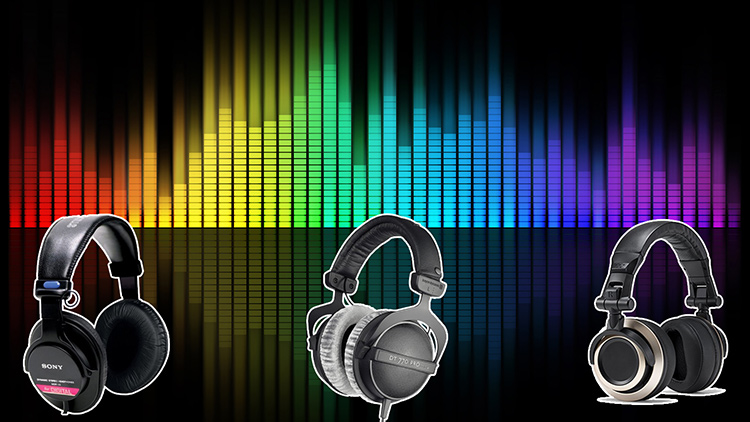
An in depth comparison of the Sony MDR V6, Beyerdynamic DT 770 PRO and Status Audio CB-1 headphones based on facts and opinions.
2021 Update: I still use the Sony MDR V6 today but I noticed they jumped from $80 to $350 since I wrote this post in 2016. The MDR 7506 is supposedly very close to the V6 in terms of sound and is closer to $80 so I’ve updated this post to link to the MDR 7506 instead. If I were buying a new pair of headphones today it would the MDR 7506 model.
Imagine how terrifying it would be if you woke up one day and came to realize that for your entire life, your perception of what the color orange is was actually brown.
That’s what life is like when you’ve spent most of your life using low budget oriented headphones. Your perception of musical reality is skewed based on your own limited experience.
It’s difficult to even process this because what you perceive as “good” might not even be good at all because your headphones are unable to send your ears certain frequencies. It’s not your fault.
What sounds good to you might sound cringe worthy to me and it has nothing to do with “having an ear” or being some type of audio engineering wizard.
While I am super passionate about music and occasionally play the guitar I would not consider myself an audiophile, nor have I spent years locked in an audio dungeon and have gotten to the point where I can identify the frequency of a toilet flush by ear.
I’m just a dude who enjoys music and wants to improve the audio quality of my video courses.
# Upgrading My Headphones Left Me Speechless
I did buy a few pairs of headphones recently and even the worst of the 3 sounded so much better than my budget Sennheiser HD 201 headphones that I instantly got goosebumps and I was awestruck.
I think this might be the first time I ever used “awestruck” in a sentence so don’t take me throwing around that word too lightly. After hearing some of the music I listen to on each pair, I was moved in a way that I didn’t think was humanly possible.
If you’re picturing some guy tearing up while listening to Opera then wipe that from your brain and replace that with a dude questioning reality and looking at the floor to make sure it wasn’t moving because it felt like the Earth dropped after hearing a low guitar riff in a song.
My brain was confused. It was the first time it has ever experienced a series of frequencies that low. That set in some type of fight or flight response and got me to think “Nick, the Earth is being ripped apart under your feet, you better look down to make sure you don’t get engulfed and melted by the Earth’s core”.
Following that was a series of emotional responses that ranged from pure and utter excitement to disbelief because I couldn’t believe sound quality made that big of a difference.
# What Makes Headphones So Different?
After about half a day of listening to music and spot checking my previously recorded courses I wanted to understand what was causing the headphones to sound so different.
The jump from my ultra budget HD 201s to any of the 3 higher quality headphones was massive, but the difference between the 3 better headphones was more subtle.
It was still very noticeable, and I was able to clearly pick out the pair I liked best without question.
I’m sure there’s a lot of variables in this equation but one of the biggest is how the equalizer (EQ) of the headphones are balanced at a hardware level.
This is about as deep as I went and during my research I found a website that lists out the frequency balance of many popular headphones. You can find that at http://graphs.headphone.com/.
# What Headphones Are We Comparing?
Before we get into that graph, here’s the 3 headphones I’m comparing, and for good measure I included my existing HD 201s for comparison:
| HEADPHONES | OHMs | PRICE |
| Beyerdynamic DT 770 PRO | 250 | $200 |
| Sony MDR 7506 / MDR V6 | 63 | $80 |
| Status Audio CB-1 | 40 | $80 |
| Sennheiser HD 201 | 24 | $25 |
What the Hell Are Ohms?
I included the Ohms because headphone impedance is worth mentioning. If you want to read the gory details on that, check out this great article on head-fi.org.
The main take away is that higher Ohms doesn’t necessarily mean better sound, but higher Ohms will mean a higher power requirement to power the headphones.
Tell tale signs of a device not giving adequate power to your high Ohm headphones would be very low volume and very loose sounding muddled bass.
I did not experience that on the DT 770 PROs with my desktop’s Realtek ALC892 on-board sound card. Apparently even decent smartphones can power 250 Ohms well enough.
Audiophiles will say that you should buy an amplifier to get the most out of 250 Ohm+ headphones and perhaps there is truth to that but I imagine the difference would be minimal.
You can get decent USB amplifiers for around $50-100 bucks. A fairly high rated one is the FiiO E10K and will run you around $75. I personally didn’t get it because I found that my sound card produces normal volume and clear playback.
Looking at the Frequency Graph
Here’s the graph which compares 3 out of the 4 headphones in my possession:
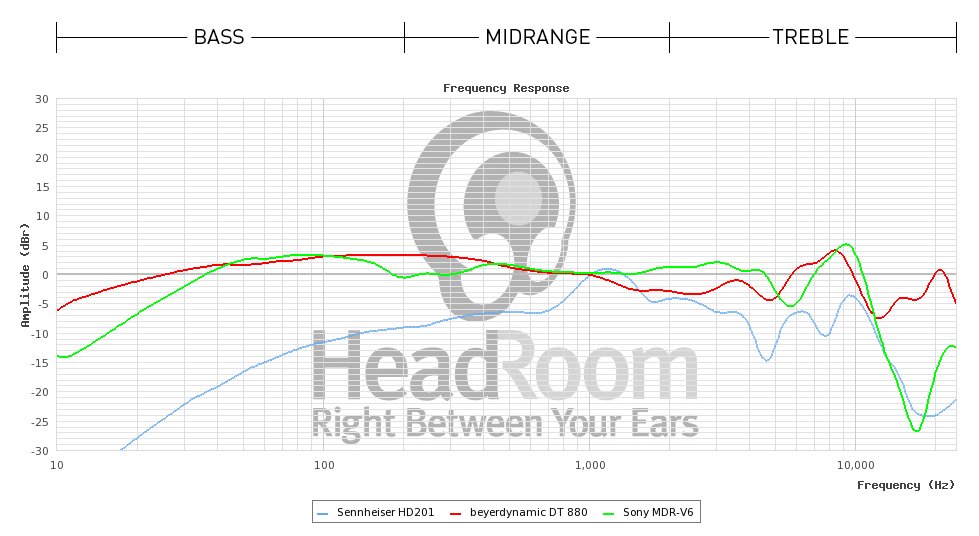
Unfortunately they don’t have an entry for Status Audio CB-1 headphones but if I were to guess, their low end is somewhere in between the HD 201s and MDR 7506 / MDR V6 with about the same high end as the MDRs too.
Making Sense Out of Frequencies
In case you don’t know, hearing is frequency based. There are low frequencies and high frequencies.
A human’s hearing range is from 20 Hz to 20,000 Hz. If you ever took a hearing test at school, they test your hearing by playing back frequencies and you need to identify when you can hear them by raising your hand.
For comparison dogs can hear up to 40,000 Hz, certain dolphins can pick up sounds at 150,000 Hz and a crazy ass wax moth called the Galleria Mellonella can identify sounds up to 300,000 Hz.
If you’re wondering why the above graph only goes up to 10,000 Hz, that would be an excellent question because I thought the same thing during my research.
You would hate music if you were exposed to frequencies even at 10,000 Hz. For example, check out this tone generator site and try playing back what 10,000 - 20,000 Hz sounds like but MAKE SURE YOUR HEADPHONES ARE AT A LOW VOLUME BEFORE DOING THAT TEST.
I’m sure now you realize why dog whistles are so effective. Imagine if someone blew 15,000 Hz in your ear at a high volume. It is a form of torture. :/
Most instruments are in the 30 Hz to 6,000 Hz range and the human voice mainly falls in the 60 Hz to 1,500 Hz range with harmonics up to about 3,000 Hz. That’s why the graph caps out at 10,000 hz.
Evaluating the Graph With Basic Frequency Knowledge
With no prior knowledge about frequencies you might think the DT 770 PROs are the most neutral headphones because of how close they are to 0 in the full range of frequencies.
Neutralness is great for getting an accurate representation of what sound REALLY sounds like.
Studio professionals strive for neutral headphones to ensure they mix tracks with a specific sound they intend. For someone like me, I strive for the same thing because I want to make sure my voice recordings are crystal clear and balanced to sound great for my specific voice.
Realistically the DT 770 PROs are the least neutral headphones of the bunch, not counting the HD 201s which have almost no low end and a hilariously imbalanced high end.
You see, headphone manufacturers understand that most people only care about what sounds good. It doesn’t matter if it’s accurate or not. A lot of people listen to bass heavy music, so the DT 770 PROs have the low end really jacked up and then they compensate for that by having painfully boosted high ends.
Most people will put these headphones on and be like “ZOMG the bass is so good”, while they listen to their rap music. The DT 880 and DT 990 (and to a lesser extent the 770) headphones are notorious for having fatigue inducing high ends and I could hear it even with the 770s.
There’s just something about them. The high ends felt very over cooked and left me feeling worn out after listening to them for a while. It’s not surprising if you look at the graph.
The red line around 5,000 to 8,000 Hz has a massive spike. The Sony MDRs have a spike too near 10,000 Hz but it doesn’t matter because no instruments play at that frequency.
I have a feeling the DT 770s needed to do this because the low end is so jacked up. For death metal they did sound nice but when I got the Sony MDRs a few days later my perception of what “nice” was changed a lot.
With frequency balance analysis we can clearly draw a fact based conclusion that the Sony MDR 7506 / MDR V6 headphones will give you the most neutral sounding tones of the 3. This is further backed by decades of use by audio engineers and mixing professionals. Yep, the MDR V6 and MDR 7506 headphones (nearly identical) are industry standard. You’ll find a pair lying around in most recording studios.
# Armed With Facts, Let’s Introduce Subjectiveness
Music is very subjective right? Not only do people have wildly different tastes in genres, but different people have different opinions on what sounds good.
It’s also not always about sound too. Comfort is a big deal.
Status Audio CB-1
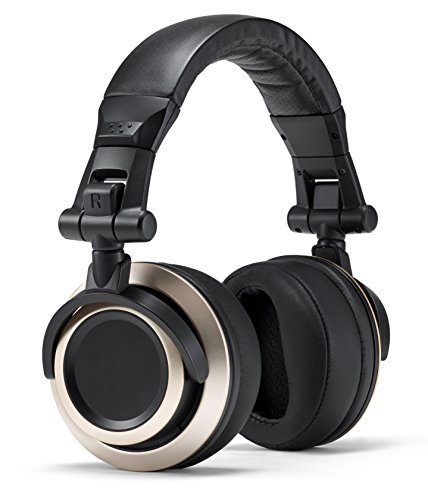
Let me first get the Status Audio CB-1s out of the way. They were the most comfortable of the 3 but they are not especially neutral and I feel like they sounded worse than the DT 770s and the Sony MDRs.
That’s a bummer because they were the only headphones in this group that had a fully detachable headphone wire. That’s very nice because these wires tend to be the first thing that goes due to how easy it is to almost kill yourself when you trip over them.
Another bummer is they were the most comfortable to me. They were a little heavy but after hours of wearing them the ear covers barely put any pressure on my head. My ears felt cool and I almost forgot I was wearing them after extended use.
None of that really matters because while comfort is important, they simply did not deliver on the sound I wanted in the end. I want this company to do well and I’ll keep an eye out on future iterations of their headphones because I think they have potential.
There’s also the OB-1 model which is an “open back” headphone. Technically open back headphones are better for monitoring but the OB-1s simply have no track record in the professional world, so I didn’t bother testing them in the end.
Beyerdynamic DT 770 PRO
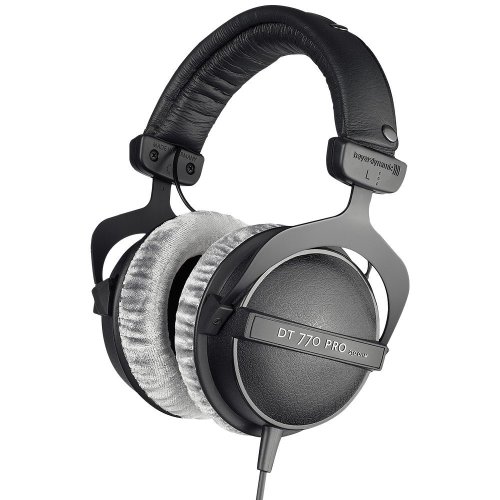
The Beyerdynamic DT 770 PROs actually arrived first in terms of shipping dates, so they left a very positive opinion on me due to them being the first “good” pair I listened to.
The ear covers are huge which is really awesome because it means nothing is pressed up against your ear which made them quite comfy. Things got a little hot inside after extended use but it wasn’t too bad.
I wore them for 5-6 hours at a time for a few days and I never really thought that they were too uncomfortable for daily full time use.
They sounded awesome for the music I like to listen to but they were just too inaccurate for getting an accurate representation of my voice recordings and I’m not good enough to account for that when mixing my audio.
I also felt like with my current set up maybe my sound card wasn’t fully capable of powering them. While the volume on them was pretty loud, they didn’t get close to the volume of the MDRs.
That’s a problem for me because when trying to detect audio imperfections, it’s important to listen to things at a pretty loud volume. Especially when you’re trying to pick up hissing sounds or subtle background noise.
They are also nearly 3x as expensive as the others and perhaps closer to 4x if you account for maybe needing to get a [USB DAC / Amplifier](https://www.amazon.com/gp/search/ref=as_li_qf_sp_sr_il_tl?ie=UTF8&tag=nickjanetakis-20&keywords=usb dac amplifier&index=aps&camp=1789&creative=9325&linkCode=xm2&linkId=4230a9e4a8e0a3e26e8fef797d6aa5a4). I don’t mind paying a little more for a better experience but my opinion on their sound changed even for music when the MDRs arrived a few days later.
That decision was pretty close but their frequency imbalance makes them unusable in the end.
Sony MDR 7506 / MDR V6
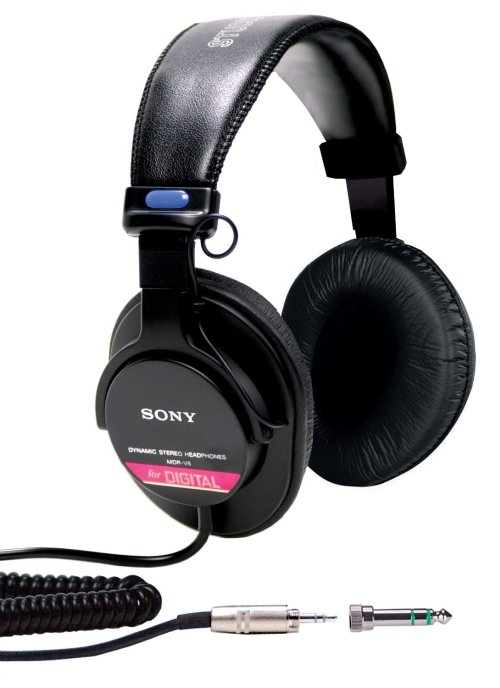
The Sony MDR V6s came in after I had already spent some time with the other 2 headphones so the bar was set pretty high.
Of the 3 they felt the lightest on my head which is awesome, but after around 2 hours of wearing them my ears felt pretty hot and in discomfort. After a few days I noticed myself having to take them off after a few hours because they actually hurt my ears. Keep in mind this is due to the ear cover size, shape and material.
It was like a dagger in my heart because they sound so good it’s stupid. I was immediately able to pick up on a lot of issues with my previous course’s recordings.
Although in my defense, out of 10,000+ students I’ve had 0 complaints on the audio quality and about 50 positive audio related feedback reports. It’s funny because with these headphones I found so many issues, it really goes to show how poor most headphones are and how tolerant people are to low quality recordings.
Can They Become More Comfortable?
Yes. Nearly every component of the Sony MDR 7506 / V6 headphones can be replaced. I am thinking about swapping out the ear covers but I’m reluctant in doing so because I know it’s going to affect the tone of them and I’m not sure I want to change their sound.
For example, I put on a beanie hat as a test and lost a tremendous amount of clarity.
My plan is to wear them with a regular hat for a bit and let them stretch out before making any decisions on replacing the ear covers.
Edit: I’ve been using them full time for about a month and they’ve become comfortable! I can barely notice them, even after wearing them for many hours in a row. Really excited that I didn’t need to replace the ear covers.
Listening to a Few Sound Samples
Comfort aside, they are incredible. They are also super solid for listening to music. Despite them being neutral their low end sounds very rich, so they have a “fun factor” to them when listening to music.
I prefer death metal and metalcore but I do listen to some trance and clean ambient music. this article could easily be another 5,000 words describing audio samples of what I like, but let me leave you with 3 samples.
These samples aren’t my favorite metal riffs. I think they just demonstrate a nice range of frequencies.
The first one is CAFO by Animals as Leaders. I’m generally not a fan of them but the intro to CAFO has abnormally deep low ends for a metal song and I love the riff. This was the song that made me feel like I was losing my footing when I first put on a good pair of headphones.
The second one is The Blind Leader by Kalmah and I time jumped to a nice demonstration of mids shortly followed by one of the best solos ever recorded in my opinion.
The last one is a black metal song called Boulevard Black by Netherbird. Check out the intro to it and listen for about 2 minutes.
Maybe it’s not for you. I know it’s niche and this is the only song of this genre that I listen to occasionally. I bothered to link it because it has a really wide frequency range. There’s extremely subtle low end beats (such as 12-13 seconds, 22-25 seconds, 35 seconds, etc.) mixed with pianos and deep growling.
On the MDR V6s I feel like I can pick out each instrument easily. I even had to turn around to make sure goblins weren’t about to ambush me from behind.
# What’s Next?
Now that my ears are capable of hearing neutral sounds at all audible frequencies, it’s on to really dialing in my voice recordings which involved an equally as intense research session on microphones.
If you have any stories about any of the headphones listed here then please leave your comments below. I’m especially interested in hearing about anyone who has modified the MDRs with custom ear covers but all comments are welcome.